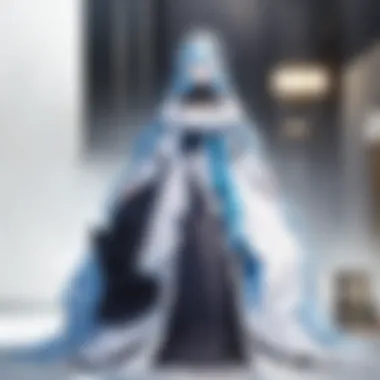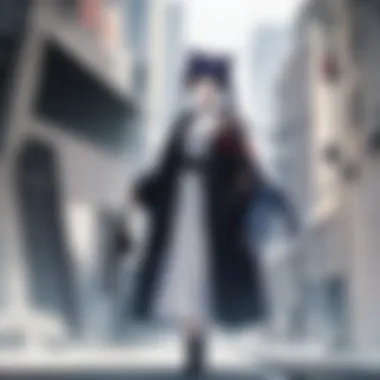Exploring Caretaker Networks in Anime and Manga


Intro
The exploration of caretaker networks in anime and manga presents a fascinating layer of narrative depth often overlooked. These networks reveal intricate relationships and the underlying dynamics that shape character arcs, plot progressions, and thematic messages. Caretakers serve as pivotal figures, guiding and nurturing other characters, impacting not only their personal development but the narrative as a whole. This article aims to dissect these networks, focusing on how various series portray these roles while reflecting on cultural dimensions of caregiving distinct to Japanese media.
Series Overview
Synopsis and Premise
In numerous anime and manga, caretaker characters often emerge in storylines that emphasize the importance of support systems. These narratives might revolve around family, friendships, or communal ties. A prime example is Mushishi, where Ginko serves as a caretaker not only in the literal sense of guiding others but also in fostering the understanding of the natural world through his interactions with different people. The interplay between caretaking and understanding leads to profound revelations about life and relationships.
Notable Characters
Some notable caretaker characters include:
- Kenshin Himura from Rurouni Kenshin: He acts as a protector, striving to atone for his past while caring for those around him.
- Hana from Wolf Children: She exemplifies a mother’s love and the sacrifices made to ensure her children’s happiness and well-being.
- Kagome Higurashi from Inuyasha: Balancing her responsibilities as both a modern girl and a warrior, she showcases the complexities of caretaking while navigating her relationships.
These characters are not merely side figures; they embody moral and ethical dilemmas often central to the narrative.
Themes and Motifs
Major Themes Explored
The thematic currents running through these narratives often center around sacrifice, responsibility, and emotional resilience. Caretaker characters frequently face challenging moral decisions that explore human vulnerability and strength. Their roles prompt viewers and readers to reflect on the implications of caretaking in their own lives. Series like Your Lie in April center on how caretaking can lead to both healing and strain, capturing the duality of such relationships.
Symbolism in Storytelling
Caretaker networks are rich in symbolism. The act of caretaking itself can symbolize community, connectivity, and the intricate web of dependence among characters. The land, nature, or even objects may accompany caretaker roles, reflecting their emotional states or the burden they carry. Such symbolism enhances the storytelling, making the audience question the implications of each relationship presented.
"Caretaking roles often challenge conventional character development, inviting viewers to see love and responsibility in a multifaceted light."
Artistic Style and Animation
Visual Aesthetics and Design
The artistry in these genres often complements the complexity of caretaker networks. Artists utilize a distinct animation style to embody the nuances of caregiving scenes. In Clannad, soft colors and detailed backgrounds create an intimate atmosphere that highlights emotional moments, making the act of caretaking resonate strongly with viewers. Each character is crafted with attention to emotional expression, reinforcing their roles within the network.
Animation Techniques and Trends
Trends in animation, such as fluid transitions and expressive character design, enhance storytelling. Series like Attack on Titan employ rapid shifts in animation style during caretaker interactions, reflecting emotional tensions and resolutions. Caretaker networks require not only strong writing but also visual storytelling that resonates with the audience's emotions.
This examination of caretaker networks in anime and manga shows how these characters influence narratives. Their interactions open discussions about societal values and the nature of relationships, offering rich material for scrutiny and appreciation.
Foreword to Caretaker Networks
The concept of caretaker networks is vital in understanding anime and manga. These networks reflect the intricate dynamics between characters. At the core, caretaker networks reveal how relationships shape narratives. They highlight themes such as sacrifice, resilience, and emotional growth. By exploring these networks, we gain insights into broader cultural contexts.
Defining Caretaker Networks
Caretaker networks refer to the relationships between characters who provide care and support to others. The caretaker may be a parent, a friend, or even a mentor. Their role often involves emotional, physical, or psychological support. This concept is not limited to direct care but includes the networks formed through bonds.
The essence of caretaker networks lies in the interconnectedness of these roles. Characters influence each other significantly. For instance, a mentor may guide a younger character while also drawing strength from them. This mutual interaction enriches storytelling and character development. It fosters a sense of community, even in fictional settings.
Significance in Anime and Manga
In anime and manga, caretaker networks are more than just plot devices. They embody cultural values and norms surrounding caregiving. These narratives explore not only personal bonds but also societal expectations. Caretaker roles reveal the balance between individual desires and communal responsibilities.
The exploration of these roles often leads to critical character arcs. Characters evolve through their relationships, facing challenges and growth opportunities. They undergo transformations that reflect larger societal themes. For example, the portrayal of a child learning from a wise guardian emphasizes the cyclic nature of learning and legacy.
"Through the lens of caretaker networks, viewers glean deeper insights into emotional and relational aspects of life in Japan."


Thus, caretaker networks serve as a foundation for understanding emotional depth in anime and manga. They provide a rich tapestry of interactions that resonate with audiences. In examining these relationships, we unlock deeper meanings embedded within the stories.
Historical Context of Caregiving in Japanese Media
Understanding the historical context of caregiving in Japanese media allows us to appreciate how these concepts evolve within anime and manga. Traditional values play a crucial role in shaping the portrayal of caretaker characters. In the landscape of storytelling, these characters not only reflect society's views but also resonate with audiences through their complex narratives. This section sheds light on the roots of caregiving in Japan and highlights the evolution of these archetypes over time.
Traditional Views on Caregiving
In Japan, caregiving has often been viewed through the lens of social duty and familial obligation. Historically, the Confucian influence has emphasized the importance of family hierarchies and the roles individuals play within these structures. This perspective creates a cultural backdrop where caretakers are often depicted as selfless figures committed to their responsibilities.
Within anime and manga, these traditional views translate into poignant narratives. The caretakers, often parents or elder siblings, embody the ideals of support and sacrifice. Their actions not only drive the plot but also shape the moral lessons conveyed throughout the story. Many popular series, such as "Spirited Away," prominently feature caregivers who sacrifice their own desires for the well-being of others, thus reinforcing the cultural significance of these themes.
Evolution of Caregiver Archetypes
As society transitions through modern challenges, so too do the archetypes of caregivers. Over the decades, manga and anime have begun to showcase a broader range of caregiving roles. While parental figures remain common, there is a noticeable shift toward the representation of non-traditional caregivers. This includes friendships that resemble familial bonds and mentors who play pivotal roles in character development.
This evolution also mirrors changing societal norms. Contemporary narratives often explore the struggles of caregivers, revealing their flaws and vulnerabilities. For instance, in series such as "My Hero Academia," characters who take on caretaker roles also face their own challenges and doubts, providing a more nuanced portrayal of caregiving. The dynamic interactions between caregiver and recipient allow for greater depth in storytelling, engaging audiences on multiple emotional levels.
In essence, the representation of caregivers has become more complex, challenging traditional perceptions while still paying homage to foundational values.
This historical perspective informs our understanding of the current trends in Japanese media. By examining how caretaking roles are portrayed, we uncover the intricate tapestry of human relationships that define much of anime and manga today.
Types of Caretakers in Manga and Anime
In the rich tapestry of anime and manga, the role of caretakers stands out due to their profound influence on character arcs and plot development. These figures are not merely supporting characters; they play critical roles that can define the course of the narrative. Caretakers can be diverse in their relationships, backgrounds, and motivations. Their interactions with main characters often drive the themes of selflessness, resilience, and growth. Examining the types of caretakers in these media illuminates the complexity behind their roles and adds depth to the stories they inhabit.
Parental Figures
Parental figures are perhaps the most recognizable type of caretakers in anime and manga. They often embody a blend of authority, guidance, and unconditional love. Characters such as Maes Hughes from Fullmetal Alchemist illustrate this well. A loving father, Hughes is fiercely protective of his family and friends. His presence illustrates how a caregiver can impact character decisions profoundly, steering them toward a path of morality and integrity.
However, not all parental figures are perfect. Some narratives showcase flawed or absent parents, which in turn shapes the protagonists' circumstances and motivations. For example, in Naruto, the absence of Naruto's parents drives much of his longing for connection and identity. This dynamic creates a layered representation of caregiving, where the lack thereof becomes just as crucial as the presence.
Siblings and Friends
Siblings and friends also hold essential roles in caregiving. These characters often present a more relatable form of support compared to parental figures. In My Hero Academia, Izuku Midoriya's friendships with characters like Ochaco Uraraka reflect mutual growth and encouragement. Their relationships emphasize how comradeship can be a powerful form of care, providing emotional stability and motivation.
The caregiver dynamic between siblings can also be compelling. In One Piece, the bond between Luffy and his crewmates illustrates how friendships create a surrogate family. Characters assist one another through challenges, showcasing that caregiving often extends beyond blood relations.
Mentors and Guides
Mentors and guides serve a unique niche within caretaker networks. They provide training, wisdom, and guidance, impacting a character’s development. Figures like Jiraiya from Naruto exemplify the mentor archetype. They not only impart skills but emotional fortitude, shaping the protagonist’s identity and resolve.
Mentors often challenge their protégé’s perspectives and push them toward self-improvement. The relationship can be seen as a twofold care, where both the mentor and mentee contribute to each other's growth. This dynamic highlights the notion that caregiving in anime and manga often transcends traditional roles, incorporating guidance and challenge as part of the nurturing process.
Key Themes Associated with Caretaker Characters
The exploration of caretaker characters in anime and manga reveals a complex tapestry of themes. These characters do not merely serve their narrative roles; they embody significant values and provide depth to the storytelling. Understanding the themes associated with caretaker relationships is essential for appreciating their impact on plots and character arcs. The two key themes highlighted here are selflessness and sacrifice, and resilience in adversity.
Selflessness and Sacrifice
Selflessness is a prominent theme that frequently appears in the portrayal of caretaker characters. These figures often put the needs of others before their own, showcasing an altruistic disposition that resonates deeply with audiences. In stories such as Your Lie in April, the main caretaker, Kaori, exemplifies this trait through her actions, prioritizing the emotional and physical well-being of others at great personal cost.
This theme is not just for character development; it also serves the purpose of enhancing the emotional core of the story. Audiences engage with these characters on a personal level, eliciting empathy and understanding. The sacrifices made by caretakers can lead to pivotal moments in the narrative, adding layers of complexity to character interactions. In this context, a caretaker's selflessness often drives the plot forward, influencing the choices and growth of other characters.
"Caretakers represent the ultimate expression of devotion in anime and manga, often driving pivotal stories through their sacrifices."
Resilience in Adversity
The second key theme, resilience in adversity, showcases how caretaker characters navigate challenges while providing support to others. Their ability to endure hardship can significantly shaped the story's trajectory. For instance, in One Piece, the character Nico Robin faces numerous challenges, but her resilience inspires those around her to strive for their aspirations even in dire circumstances.
Caretaker characters often face their own struggles while helping others. This duality emphasizes their strength and highlights the central idea of overcoming obstacles. Their resilience tends to serve as a mirror to the struggles of those they care for, illustrating how partnerships are critical in navigating life's complexities. Such representations provide valuable insights into the human condition, making the themes of resilience and emotional strength relatable to various audiences.


In summary, the themes of selflessness and sacrifice, alongside resilience in adversity, form a nuanced understanding of caretaker networks within anime and manga. These themes not only shape the narrative but also engage audiences by elevating characters to relatable and inspiring figures.
Case Studies of Notable Caretaker Characters
In the analysis of caretaker networks, examining specific characters provides clarity on their roles within anime and manga narratives. Case studies illuminate how these characters embody the various dynamics of caregiving, reflecting broader themes within their respective stories. By dissecting their relationships and actions, one can gain insight into the intricacies of caretaker roles and their impact on character development and narrative progress.
Mitsuki in 'The Perfect World'
Mitsuki stands out in 'The Perfect World' as a poignant example of the caretaker role. He is depicted as a supportive figure for the protagonist, Tsugumi, who navigates the challenges of living with a disability. Mitsuki exhibits empathy and understanding, showing that caregiving transcends mere assistance. His emotional intelligence allows him to provide not just physical support but also mental and emotional guidance. This multidimensional approach reveals the significance of emotional labor in caregiving roles. The narrative uses Mitsuki's character to highlight that effective caregivers often undergo transformative experiences, reaffirming their own identities as they assist their loved ones.
Hinata in 'Naruto'
Hinata Hyuga's role in 'Naruto' exemplifies the complexity of caretaker figures in anime. Initially characterized by her shyness and lack of confidence, Hinata evolves as she steps into the role of a caretaker. Her unwavering support for Naruto embodies loyalty and selflessness, foundational traits of a caretaker network. Hinata’s character arc illustrates how caretaking promotes personal growth. As she shows strength in her commitments, not only does she aid Naruto, but she also strengthens herself. This duality is significant because it underscores that caretaking can lead to mutual development within relationships. The series uses Hinata to explore both the burdens and rewards of caregiving.
'Barakamon' and Community Caretaking
'Barakamon' offers a broader perspective on caretaking by exploring it within a community context. The protagonist, Seishuu Handa, moves to a rural village where he encounters local children and residents who inadvertently become caretakers in his journey of self-discovery. The interactions with the villagers serve as a form of care, enriching Handa's life and nurturing his artistic talents. This community network reinforces the idea that caregiving extends beyond familial or traditional relationships. In 'Barakamon', the caretaking dynamic fosters connections among individuals from diverse backgrounds, revealing how collective support can lead to personal and communal growth. The series poignantly illustrates that care can reside in the simplest acts of kindness, resonating deeply throughout the community.
Cultural Representations of Caretaking
Cultural representations of caretaking play a crucial role in understanding how anime and manga reflect and shape societal views on caregiving. These representations serve as a mirror to Japanese culture, showcasing the intricate balance between individual needs and communal responsibilities. The portrayal of caretakers often addresses significant cultural themes such as gender roles, family dynamics, and the expectations placed upon individuals within a community. By analyzing these elements, one can gain insight into how caretaking is both celebrated and scrutinized in the narratives.
Representations of caretaking contribute not only to character development but also to the narrative depth of stories. Characters who assume caretaker roles often experience personal growth, which resonates with the audience. The complexity of these roles delves into the sacrifices and burdens faced by caretakers, unearthing emotional truths that add weight to their journeys in the storyline. For example, characters like Hinata in 'Naruto' illustrate how the act of caregiving can lead to resilience and self-discovery, thus enriching the viewer's experience.
Gender Roles in Caregiving
In anime and manga, gender roles are often portrayed with nuance, especially within the context of caregiving. Traditionally, women have been depicted as primary caregivers, fulfilling roles that encompass nurturing and emotional support. Titles such as 'Fruits Basket' and 'Inuyasha' showcase female characters who embody these traits, often representing idealized motherhood or sisterhood. However, these roles can also limit the portrayal of male characters, who are sometimes relegated to secondary positions when it comes to caregiving.
That said, there has been a recent shift in representation. More male characters are emerging as caretakers, demonstrating the evolving nature of gender roles in contemporary works. For instance, in 'Barakamon', the male protagonist, Handa, assumes an unexpected caregiving role, challenging traditional stereotypes and highlighting the emotional depth of male characters.
"The evolving dynamics of caregiving through gendered lenses not only provide fresh narratives but also encourage an introspective examination of societal expectations."
Family Structures and Expectations
Family structures in anime and manga often reflect the diverse realities of Japanese society. The traditional nuclear family is frequently depicted, yet many series explore unconventional arrangements. Single-parent households, blended families, and chosen families emerge as prominent themes, revealing the complexities and varying expectations of caretaking relationships.
These variations in family dynamics significantly impact the characters' roles as caretakers. In 'My Neighbor Totoro', for instance, the sisters’ bond and their interaction with the nature spirit demonstrate how caregiving can extend beyond familial ties, creating a sense of community. The emotional connections forged through these relationships emphasize the importance of support systems, whether biological or chosen.
Overall, the representation of caretaking in anime and manga is multidimensional. By examining gender roles and family structures, one can better understand how these narratives challenge or reinforce cultural norms and expectations around caregiving. As the landscape of Japanese media continues to evolve, so too will the representations of caretakers, potentially offering a more inclusive and diverse narrative landscape.
Implications of Caretaker Relationships
The role of caretaker characters in anime and manga holds significant weight, not just within story arcs but also influencing the characters' overall development and the narratives' resolutions. By exploring caretaker relationships, we can gain insights into how these connections shape themes of loyalty, trust, and personal growth. They serve as a foundation for emotional and psychological complexities that drive the story forward.
Impact on Character Development
Caretaker relationships in anime and manga often serve as pivotal points for character development. The presence of a caretaker can reveal various traits in characters, including vulnerability, strength, and resilience. For instance, characters who receive care often show growth through adversity, learning from their experiences.
This growth is sometimes depicted through a transformative arc, showcasing how nurture can lead to personal empowerment. Characters like Mitsuki in 'The Perfect World' embody this shift, as their reactions to their caretakers evolve from reliance to independence. The careful crafting of these dynamics can connect deeply with the audience, making the journey relatable and poignant.
Furthermore, caretakers often mirror or contrast the traits of those they support. This juxtaposition can expose deeper issues or motivations, creating layers in character relationships. Through such interactions, we witness not just emotional exchanges but also significant changes in personality and priorities. Key developments often emerge from crises, where the caretaker’s role becomes both a guide and a catalyst for the recipient's growth.
Narrative Resolutions Influenced by Caregivers
Narrative resolutions within anime and manga frequently hinge on caretaker relationships. These characters bring a level of conflict and resolution that is essential to driving the plot. Caregivers often help navigate the central conflicts, guiding protagonists towards resolution paths that may not have been visible initially.
For instance, in 'Naruto', the character of Hinata serves as more than just support; she represents hope and determination. Her relationship with Naruto aids in resolving personal and external conflicts. This dynamic enhances plot progression, illustrating how the role of the caretaker can lead to critical turning points.
Moreover, the resolutions derived from caretaker relationships tend to encapsulate broader themes of redemption and healing, offering a rich tapestry of emotional closure. They reflect societal values, emphasizing that personal growth often comes through connection and understanding. By focusing on these interactions, creators provide depth to their narratives, making the characters' journeys compelling and meaningful.
"Caretaker networks not only influence character trajectories but also enrich the narrative structure, enhancing both emotional and thematic depth."


Psychological Aspects of Caregiving
The portrayal of caregiving in anime and manga reveals significant psychological dimensions. This aspect plays a crucial role in understanding the depth of caretaker networks within these narratives. Caregiving is often laden with emotional complexity, highlighting both the burdens and the profound influence caretakers have on the lives they touch. By examining the psychological framework of caregiving, we can appreciate the intricate dynamics that define relationships between caregivers and their charges. This section will discuss the specific elements of caregiving psychology, the benefits of understanding these perspectives, and considerations relevant to this topic.
The Caregiver’s Burden
Caregivers in anime and manga frequently encounter what is known as "the caregiver’s burden." This term encapsulates the mental and emotional strain experienced by those who assume the role of caretaker. In numerous stories, characters who provide care often prioritize their responsibilities above their own needs. This self-sacrifice can lead to stress, anxiety, and feelings of overwhelming responsibility. Characters such as Hinata from "Naruto" demonstrate how such burdens can impact personal growth. While caregivers often appear strong and supportive, they can struggle internally with their duties.
Unpacking this theme reveals that the caregiver's role can sometimes lead to isolation. They may feel disconnected from their peers, who do not share the same experiences. This isolation can intensify feelings of guilt when caretakers seek help or support for themselves. Furthermore, the burden can create a cycle of emotional suppression, where caregivers ignore their own needs to focus solely on those they care for.
- Key Points about the Caregiver’s Burden:
- Emotional strain can lead to loneliness.
- Sacrificing personal needs may result in negative mental health outcomes.
- There is a need for dialogue around the caregiver's experiences to foster understanding.
Effects on Recipients of Care
The relationship dynamics shaped by caregiving are not one-sided. The psychological effects on recipients of care are equally significant and deserving of attention. In many anime and manga series, the presence of a caretaker influences the emotional and psychological development of the individual receiving care. The feelings of security and support can enhance the recipient's ability to cope with their challenges.
However, it is essential to recognize that the effects can vary. Some recipients may develop dependency on their caretakers, struggling to emerge from the shadow of their support. Conversely, through their experiences with caregiving, some characters may find resilience and strength, leading to improved emotional well-being.
- Considerations Regarding the Effects on Recipients:
- Relationships can promote healing or dependency.
- The quality of care significantly impacts the emotional growth of the recipient.
- Awareness of caretaking dynamics can enhance narrative depth in storytelling.
Recognizing the psychological aspects of caregiving enriches the narratives in anime and manga. Understanding the burden faced by caretakers and the effects on care recipients provides critical insights into character development and thematic exploration.
Future Trends in Caregiver Representation
As anime and manga continue to evolve, the representation of caregiver roles also transforms. The importance of examining future trends in this area lies in how these narratives reflect societal changes, attitudes towards caregiving, and the expectations placed on characters within their respective universes. By recognizing these shifts, creators can offer more nuanced portrayals, leading to deeper character development and relatable storylines.
Emergence of Non-Traditional Caregivers
In recent years, there has been a noticeable rise in the depiction of non-traditional caregivers. This trend includes characters who diverge from typical gender roles or familial expectations. For instance, figures such as Yato from "Noragami" and Koro-sensei from "Assassination Classroom" illustrate how caretaking can come from backgrounds atypical to traditional practices.
- Mentor Figures: Often portrayed as unorthodox, the mentor figure frequently adopts the caretaker role in unexpected contexts. They guide younger characters while also grappling with their own pasts.
- Community Caregivers: Series like "Barakamon" showcase how entire communities can act as caretakers. This inspires a sense of unity, emphasizing that caregiving is not limited to familial ties.
By embracing these diverse caretaking roles, anime and manga challenge stereotypes, opening avenues for varied narratives.
Changing Narratives in Contemporary Works
The landscape of storytelling in anime and manga has shifted, allowing for more complex caregiver narratives. Traditional tropes are reexamined and deconstructed in contemporary series. This contrasts sharply with earlier works where caregiver roles were often predictable.
"Contemporary narratives explore the psychological impact of caregiving on both the giver and recipient, revealing deeper layers of interaction."
- Psychological Depth: Characters like Shinji Ikari from "Neon Genesis Evangelion" reflect the emotional turmoil faced by caregivers. Their flaws and insecurities make them relatable.
- Expanded Roles: Series now often depict caregivers that are not solely nurturing. They display a wider range of emotions, facing their own struggles while caring for others.
This evolution not only enriches character arcs but also resonates with audiences. It reflects a more comprehensive understanding of caregiving that aligns with modern societal dynamics.
In summary, the examination of future trends in caregiver representation highlights the necessity of evolving narratives. Non-traditional caregivers and changing story arcs offer fresh perspectives that resonate with current audiences, ensuring that anime and manga remain relevant in addressing complex human experiences.
Finale
The concept of caretaker networks plays a vital role in understanding narratives within anime and manga. As we have explored throughout this article, caretaker characters deeply influence both plot development and character growth. These networks showcase the interconnectedness of relationships, emphasizing how each character's role can impact another's journey.
Summary of Key Findings
This analysis reveals several key findings about caretaker networks. First, caretakers often embody themes of selflessness and sacrifice, illustrating the emotional depth present in many series. Second, the evolution of caregiver archetypes reflects broader changes in societal views, revealing how modern narratives challenge traditional gender roles and family dynamics.
Third, case studies of characters like Mitsuki in 'The Perfect World' and Hinata from 'Naruto' highlight specific examples of how these roles function within their narratives. Lastly, the psychological aspects of caregiving expose the burdens held by caretakers, which can create significant narrative tension.
"Caretaker networks in anime and manga are essential for exploring deeper themes of human interaction and emotional trauma."
The Future of Caretaker Networks in Media
Looking ahead, the representation of caretaker roles in media is likely to undergo further transformation. We may witness a rise in non-traditional caregivers, as stories become more inclusive and diverse. The exploration of complex relationships beyond simplistic archetypes will enrich narratives and resonate more with audiences.
As contemporary works evolve, it will be crucial to pay attention to how these shifts reflect or challenge societal norms surrounding caregiving. The potential for rich storytelling remains high, as caretaker characters continue to shape and be shaped by the world around them. Caretaker networks are not just supporting pillars in the narrative; they are fundamental to the stories being told, influencing every facet of character development and thematic exploration.

